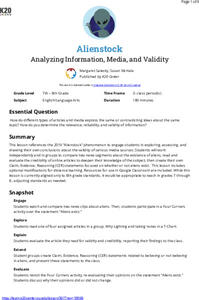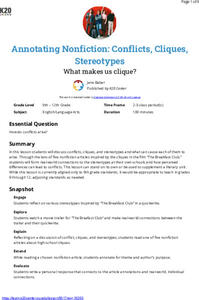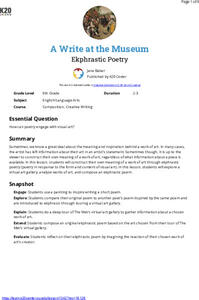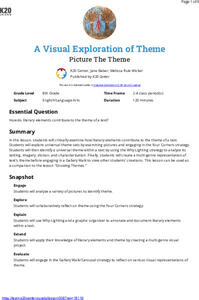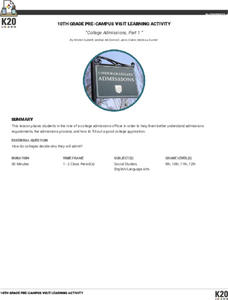K20 LEARN
Bear Tale: Author's Purpose - Informing Or Entertaining
After reading The Mitten by Jan Brett, scholars discuss the author's purpose. Small groups compare and contrast a book written to entertain and a book to inform, then create a T-Chart detailing the characteristics of each. Learners...
K20 LEARN
Baking Cupcakes!: Fractions
Following an engaging video, mathematicians solve a word problem about baking cupcakes using fractions. Scholars practice different problem-solving strategies, then find different ingredient amounts for their recipes. Pupils solve a...
K20 LEARN
A Way With Words: Copy Editing And The Writing Process
Learning to edit copy using correct grammar and mechanics is an essential skill in school—where scholars are called upon to edit their peers' writing—and in business. Class members practice this skill by first editing a provided article...
K20 LEARN
#Summarize: Summarizing
What are the effects of one's life experiences? Class members view a slam poetry reading, a speech by President Obama, and read a short story by John Steinbeck about responding to tragedies. They summarize these events and then craft a...
K20 LEARN
Allow Me To Introduce Myself: Writing A Letter Of Introduction
"Who am I?" is not only a great philosophical question that requires a lot of reflection but is also at the heart of a letter of introduction. The challenge, of course, is figuring out where to start. Middle schoolers get a little help...
K20 LEARN
Active Or Passive?—"The Monkey's Paw": Grammar/Language Usage
Don't you wish you could use passive voice? Be careful what you wish for! "The Monkey's Paw" is the focus of a grammar and language usage lesson about active and passive voice. Readers identify examples of active and passive voice in...
K20 LEARN
(Not Quite) Breaking All The Rules: Poetry And Grammar
FANBOYS will enjoy breaking grammar rules, but they will have to use coordinating conjunctions, gerunds, compound sentences, compound-complex sentences, and even predicates as they craft poems like Shel Silverstein.
K20 LEARN
Alienstock: Analyzing Information, Media, And Validity
One only has to watch MSMBC and FOX News to realize that media can present the same story in very different ways. Middle schoolers have an opportunity to test their ability to determine the validity and trustworthiness of information by...
K20 LEARN
Annotating Nonfiction - Conflicts, Cliques, Stereotypes: What Makes Us Clique?
John Hughes' The Breakfast Club takes center stage in a lesson about annotating nonfiction texts to keep track of evidence that may be used later in discussions and writings. Scholars consider the stereotypes and conflicts presented in...
K20 LEARN
A Write At The Museum: Ekphrastic Poetry
Which came first—the painting or the poem? In this case, it is the painting. Scholars closely examine a work of art and then craft an ekphrastic poem in response. A carefully scaffolded nine-page plan leads young poets through the process.
K20 LEARN
Antigone's Themes Today: The Greek Drama Antigone
Is Antigone relevant to today's readers? After reading Sophocles' tragedy, scholars must decide if the themes are universal and timeless. Class members engage in a series of activities designed to have them closely consider the...
K20 LEARN
Chicken Truck: Writing Algebraic Expressions
How did the chicken travel down the road? Given a picture of a chicken truck, class members brainstorm what information they need to determine the total number of chickens on the truck. Pupils research for the information and devise a...
K20 LEARN
You’re The Network: Data Analysis
How do you rate? Young scholars use graphical data to analyze ratings of different television episodes. Their analyses include best-fit lines, mean, median, mode, and range.
K20 LEARN
Whoopsies, Graphing Edition: Coordinate Plane Graphing
How do you handle common mistakes in your classroom? A graphing activity prepares scholars to recognize common misconceptions when graphing ordered pairs. The activity concentrates on three common graphing mistakes.
K20 LEARN
A Visual Exploration Of Theme: Picture The Theme
"What is the theme of this story?" Now there's a question that can strike fear in the hearts of learners. Here's a lesson that uses photographs to introduce the concept of theme. Scholars examine six photographs and then attach a theme...
K20 LEARN
If Our Classroom Were The World: Proportions And Percents
It's a small world after all. Classmates consider world population, languages, and religions in a cross-curricular instructional activity. Applying percentages and proportions, they determine what the class make-up would be if the class...
K20 LEARN
Active Shakespeare: Making Shakespeare Accessible
Two sonnets, both alike in theme and story, break from ancient language to new glory. The prologue to Act I of Romeo and Juliet provides scholars with an opportunity to examine the language Shakespeare uses to create timeless stories....
K20 LEARN
Analyzing Literary Figures: Analyzing Literature
The author study gets an update in a research project designed for high schoolers. Scholars search for information about literary figures that connects them to their times, their works, their themes, and other writers. Researchers also...
K20 LEARN
"The Lady, Or The Tiger?" Which Do You Choose?: Internal and External Conflict
"How come there's no ending?" After a close reading of Frank R. Stockton's tale "The Lady, or the Tiger?" in which scholars examine each of the main characters' conflicts and motivations, writers craft their own ending using textual...
K20 LEARN
#Unstressed #Stressed: Shakespearean Sonnets And Iambic Pentameter
Does any word rhyme with orange? Young poets try their hand at crafting a Shakespearean sonnet by first creating list of rhyming words. They then examine the use of unstressed and stressed syllables in iambic pentameter and the rhyme...
K20 LEARN
A Stone's Throw Away - The Dangers Of Tradition: The Lottery
Shirley Jackson's short story "The Lottery" is the anchor text for a lesson that teaches young readers how to use the Tip of the Iceberg strategy to go below the surface of a tale. After reading the short story and an article about the...
K20 LEARN
Here's How I Heard It: Using Folklore To Improve Close Reading Skills
"X" is for exaggeration, and "F" is for fact. To encourage close reading and to improve literary analysis skills, class members annotate fables and tall tales, like Paul Bunyan, with symbols that identify key features of this genre.
K20 LEARN
But What About Me?: Teaching Perspective In The Social Studies Classroom
How would the story of the discovery of America be different if indigenous people told it through their eyes? Individuals compare the conventional account of this moment in history to an account given by one of the native peoples. After...
K20 LEARN
College Admissions, Part 1: 10th Grade Pre-Campus Visit Learning Activity
Scholars assume the role of admissions officers to better understand the college admissions process. They evaluate five fictional college applications and work together to determine which ones meet acceptance requirements.









